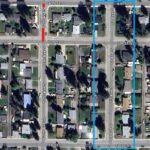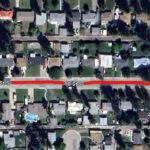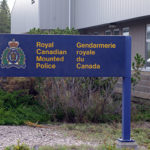Home »

A look back at the lunar eclipse
By Rick Nowell
On Sunday night, Sept. 27, a group of us went up the mountain to the TV-cell phone towers at 4,100 feet elevation, on the ridge NW of Cranbrook to take photos of the lunar eclipse.
We had a nice view with the yellow lights of Cranbrook spread out along the valley below. It was a bit windy and chilly up there, with dim red beacon lights blinking on the overhead towers. There were two other groups of people there to see the eclipse as well.
Two of the next photos (right and below and the lead image) were taken through the college’s Meade 10-inch Schmidt-Cassegrain telescope with a Nikon D100 camera at prime focus. The telescope has a 2500mm focal length mirror, with a f/6.3 focal reducer lens attached to comfortably centre the Moon in the wide 0.9 degree field of view. About 45 power magnification.
Peter Spaans was taking photos through his own Nikon on a tripod using 107mm zoom, manual focus and manual exposure times. Above right is Peter’s shot of the Moon peeking over the Steeples at 7:30 p.m. From the crescent shape, you can see the eclipse had already started. And note that mountain is 30km away.
From there, the Moon rose above the Steeples and reached the centre of the umbra shadow (totality) at about 8:50 p.m. The edge left the umbra at 9:22 p.m., according to our pictures. The umbra is the dark central shadow cone cast by the Earth, about 2.5 times the size of the Moon. The penumbra is the half shadow ring that surrounds the central cone, a bit smaller than the size of the Moon. And at the centre of the umbra, the Earth’s atmosphere layer casts a red glow, like a sunset. The atmosphere absorbs or scatters the other colours, and just red gets through.
Note the Moon is slowly moving to the east through the Earth’s shadow cone, moving to the left in its orbit.
Right you can see the circular edge of the Earth’s shadow along the centre of the Moon, as the Moon moves out of the shadow.
We packed up at 10:30 p.m., when this last photo was taken, with the Moon evenly illuminated, but still dim, mostly out of the dark umbra, and illuminated by the penumbra.
Lady in the Moon?
Looking back at the last photo, and comparing to this sketch, can you see the Lady in the Moon? She’s looking up, has a ponytail. ‘Mare’ here is Latin for sea: ancient Greeks once thought these to be seas. Mare Imbrium is the Sea of Showers. She has a serene brow, marked at top by Mare Serenitatis. Apollo 11 landed in ‘her hair above her ear,’ or the Sea of Tranquility. Her eyes are a bit tearful, marked by Mare Vaporum. Under her nose is Sinus Medii. Sinus means bay, marking her lips, and Medii means middle since it’s at the centre of the Moon (on the equator by the prime meridian). The two most prominent craters are Tycho and Copernicus, marked by flung out light-coloured rays of debris. Towards the bottom, Tycho Crater is her diamond necklace which formed only 100 million years ago. Copernicus Crater is just in front of her mouth and formed 800 million years ago. The Lady is a way of memorizing these features, and telling if your image is inverted or upside down (a common problem in astronomical telescopes).
Lead image: This orange-tinged photo was taken just after totality at 9:08 p.m., when the Moon was very dim. Note a couple of white stars beside the Moon, normally drowned out by the bright disc. For a brief time, the sky went very dark, and all the stars and the glowing Milky Way became prominent.
Photos by Rick Nowell and Peter Spaans
– Rick Nowell is the Astronomy Lab Tech at College of the Rockies







